Native Activists Halt New Drilling Near New Mexico's Chaco Canyon
Protecting some sacred sites isn't enough when the whole landscape is sacred
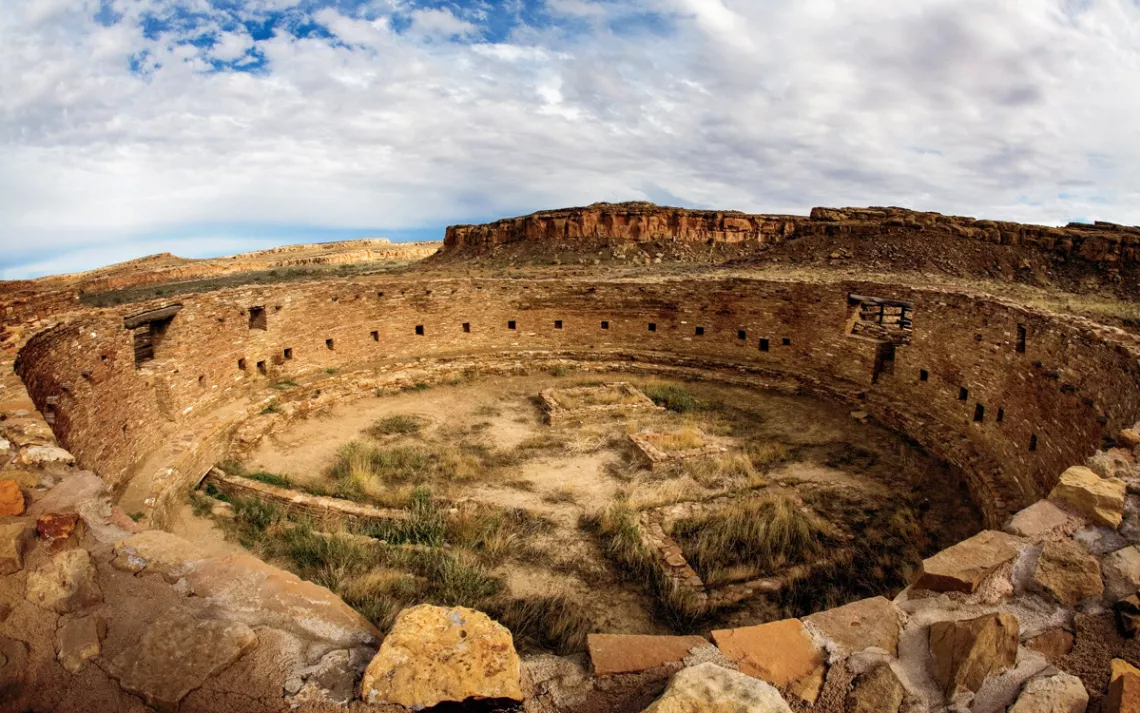
Photo by avid H. Collier/Getty Images | All other photographs by Donovan Shortey
December 21—the winter solstice. I get up in the dark, layer up against the 14-degree cold, and head out of the northwestern New Mexico town of Aztec (population 5,960). You may have heard of it: Two weeks earlier, Aztec High was the site of a school shooting. A 21-year-old white supremacist, William Atchison, shot and killed students Francisco Fernandez and Casey Marquez. Atchison apparently planned on killing many more, but a custodian saw him with a gun and alerted officials, who quickly locked down the school. When the police arrived, Atchison killed himself. Following the now-standard protocol of such tragedies, the sign at the local A&W flashes "Aztec Strong."
It's still dark when, just before the tiny Navajo community of Counselor, I turn south toward Chaco Culture National Historical Park. Driving there is like going back in time: The road starts out paved but switches to graded dirt, then a sign from San Juan County disavows further responsibilityand the road goes to hell, with deep ruts and a sketchy wash crossing. Only at the entrance to the park does pavement resume.
At 6 A.M., a ranger waves me and 99 other early risers in—past the enormous ruins of Pueblo Bonito to another one of Chaco's "great houses," called Kin Kletso (a garbled anglicization of the Navajo term for "yellow house"). We walk in the dark to the stone ruin built shortly after the Norman Conquest, gather along its north wall—almost three stories high in places, with the exquisite, smooth masonry that is Chaco's hallmark—and face east, toward a brightening sky. It's quiet except for someone in the distance playing annoying New Age music. Then, blindingly, the sun rises from its winter house, as the Navajos call it, precisely in the notch of a cliff as the Chacoan astronomers foretold, its rays lining up exactly with the north wall. Watching next to me are a Pueblo woman and her daughter, direct descendants of Chaco's astronomers and masons.
It starts to snow. The dusting of white reveals stone steps where an ancient road runs straight up the opposite canyon wall. I drive back, the funky road made even more so by the coating of snow. Through the flurries, I can see the occasional lonely house. Back at the highway, a young Navajo woman is selling cylinders of home-baked bread from the hood of her car, $5 a loaf. She brushes snow from the plastic wrapping so passersby can see what it is.
IN ITS HEYDAY—roughly the 11th century—Chaco was the apogee of civilization in what is now the United States. Until the 19th century, its 15 major buildings were the largest in North America. Pueblo Bonito, the biggest, has as many as 800 rooms and more than 30 kivas, perfectly cylindrical sunken rooms marked by holes in the floor called sipapus, symbolic reminders of the opening to the Third World below, from which Pueblo and Navajo people believe their ancestors emerged. The largest kiva at Chaco is at Casa Rinconada, on the far side of the canyon from Pueblo Bonito; in midsummer, the rising sun will shine in a window, neatly illuminating a niche in the opposite wall.
Despite a century of excavation, archaeologists still cannot agree on what Chaco was for. Steve Lekson believes it was an altepetl, a political unit of noble families based on a Central American model. Others conclude it was a thinly populated ceremonial center, a cultural crossroads attracting visitors from great distances, some of whom bore rare goods. Excavated rooms at Pueblo Bonito yielded tens of thousands of turquoise pieces, conch-shell trumpets, the skeletal remains of 30 scarlet macaws, and 111 Mayan-style cylindrical ceramic vessels that once contained chocolate, the closest source of which was 1,200 miles away.
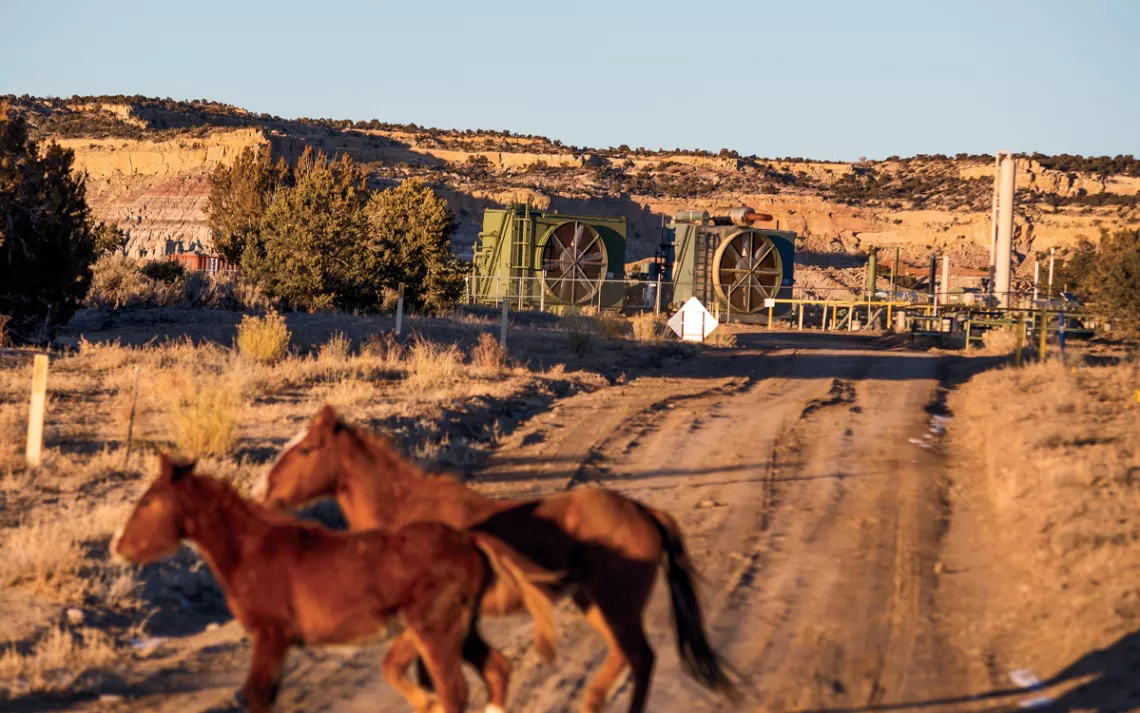
Feral horses roam the high desert landscape dotted with fracking equipment in Counselor, New Mexico.
While Chaco drew visitors from afar, it also exported its culture throughout the Four Corners region, which contains as many as 225 Chaco-style great houses, few of them excavated. The paths of cultural export may have been the nearly 200 miles of elaborate, 30-foot-wide roads that radiate from the canyon, some leading to other great houses, but others, mysteriously, heading out into the desert, going not around obstacles but directly over them. Some of these roads share the Chacoan fixation on the heavens: The Great North Road, for example, is aligned with Polaris, within half a percent of true north. Other Chacoan remnants—shrines, road fragments, sherds of their distinctive black-on-white pottery—lie scattered across the San Juan Basin.
Around 1100, the Chacoans abruptly left. They sealed the doors and abandoned the great houses. There were no signs of warfare or disease, and while the departure coincided with a period of drought, there had been many droughts before. After a period of wandering, the people of Chaco eventually resettled, some in the pueblo nations that are still inhabited to this day.
"Chaco to me is an ongoing revelation," says Thomas Vaughan, Chaco's superintendent in the late 1980s. The key to its mysteries, he says, may come from an unexcavated great house somewhere out in the middle of the San Juan Basin. "Chaco is a much bigger story than what's in that canyon."
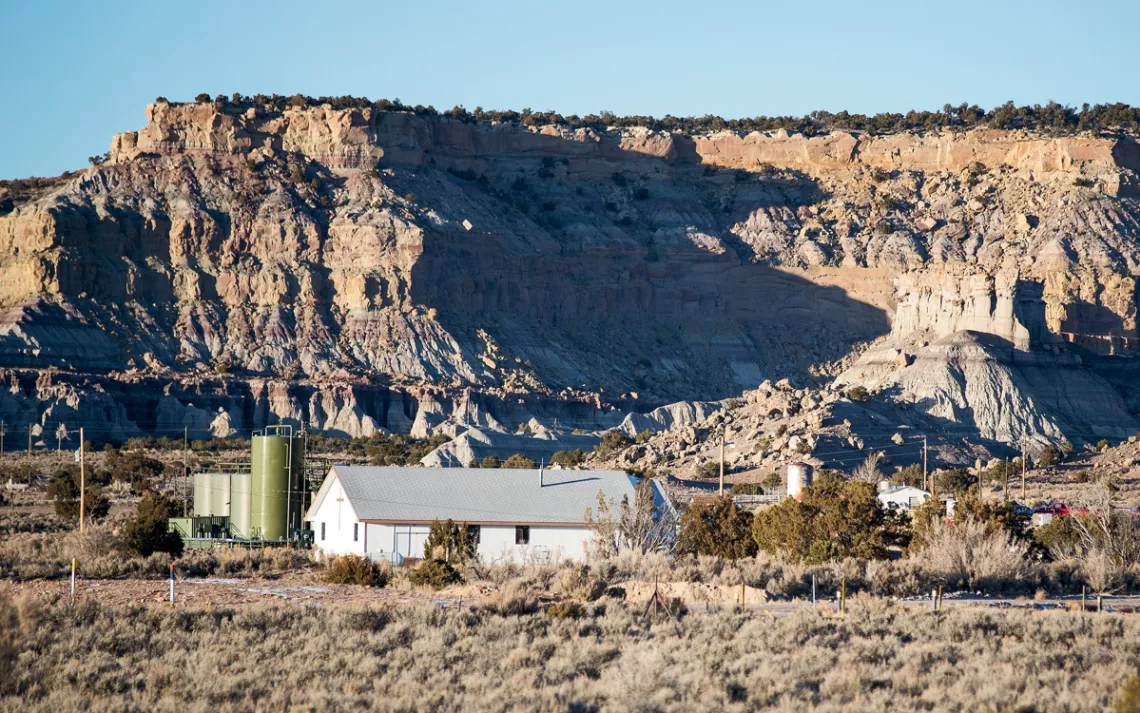
Residential homes surround gas and oil operations equipment near Counselor, New Mexico.
ALSO SCATTERED WIDELY through the San Juan Basin: fracking sites.
The next morning, I leave for the Eastern Agency, a largely Navajo area outside the Navajo Nation and north of Chaco Canyon. Beyond Aztec's fast-food joints, truck washes, and vast yards full of oil-drilling equipment, the country opens up into sagebrush steppe, the distant horizon defined by landmark mountains and mesas. It would be the stuff of tourist brochures—but for the pumpjacks, well pads, compressor stations, and flares littering the landscape.
As recently as 2003, the Bureau of Land Management said that oil and gas drilling in the greater Chaco area was not "economically viable or technologically feasible." It became so with horizontal drilling, which allows rigs to bore 7,000 feet into the earth and then at 90-degree laterals for up to two miles in any direction. Alone or in combination with hydraulic fracturing, this technology made the desert bloom with drills. From the top of a rise on Highway 550, I count 29. There are now 400 horizontal wells in the area in additionto 40,000 vertical wells, and the BLM's management plan allows for some 5,600 more vertical wells to be drilled in the next several years.
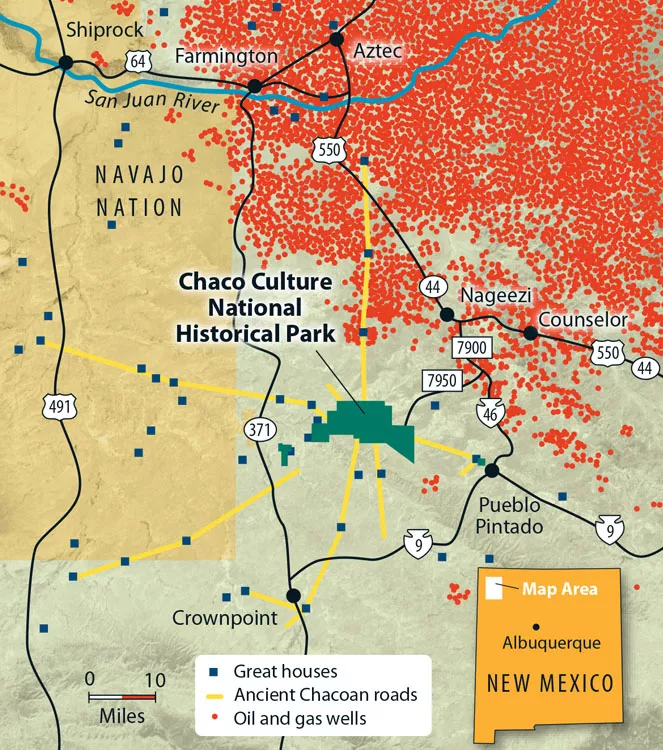
Oil and gas wells near Chaco Canyon National Historical Park in New Mexico
My destination is the dusty town of Counselor, where there's a meeting of the Tri-Chapter Alliance, with representatives from the small Eastern Agency communities of Counselor, Torreon, and Ojo Encino as well as the BLM. The Navajo participants introduce themselves to one another, at length in their liquid, breathy language and then curtly in English to the others. One gives a presentation from a "Common Language and Culture Project." Key question: How many children know the Navajo place name, history, and plant names in your community? The answer: Not many.
At the meeting is Daniel Tso, a former delegate to the Navajo Nation Council. He takes me aside and unrolls a map of the region (slipped to him, he says, by a sympathetic government bureaucrat). It shows a checkerboard of land ownership pockmarked with hundreds of oil and gas wells, current and proposed. With the exception of a narrow zone around Chaco Culture National Historical Park, there is a near-solid band of them to the east and north. The BLM has opened 4,000 square miles in the greater Chaco region to drilling and leased more than 90 percent of it—including at least 30 new wells since the Navajo Nation requested a moratorium in February 2017.
The few remaining unexploited BLM squares on the checkerboard are leased to frackers in periodic sales, which, in places like Counselor and the other Eastern Agency communities, can determine whether industrial facilities go up next to homes or schools. Until a sale in January 2017, says Kendra Pinto, a young Navajo activist at the meeting, "I didn't even know we lived on one of the parcels. But it doesn't surprise me, because that's how we've been treated out here for so long."
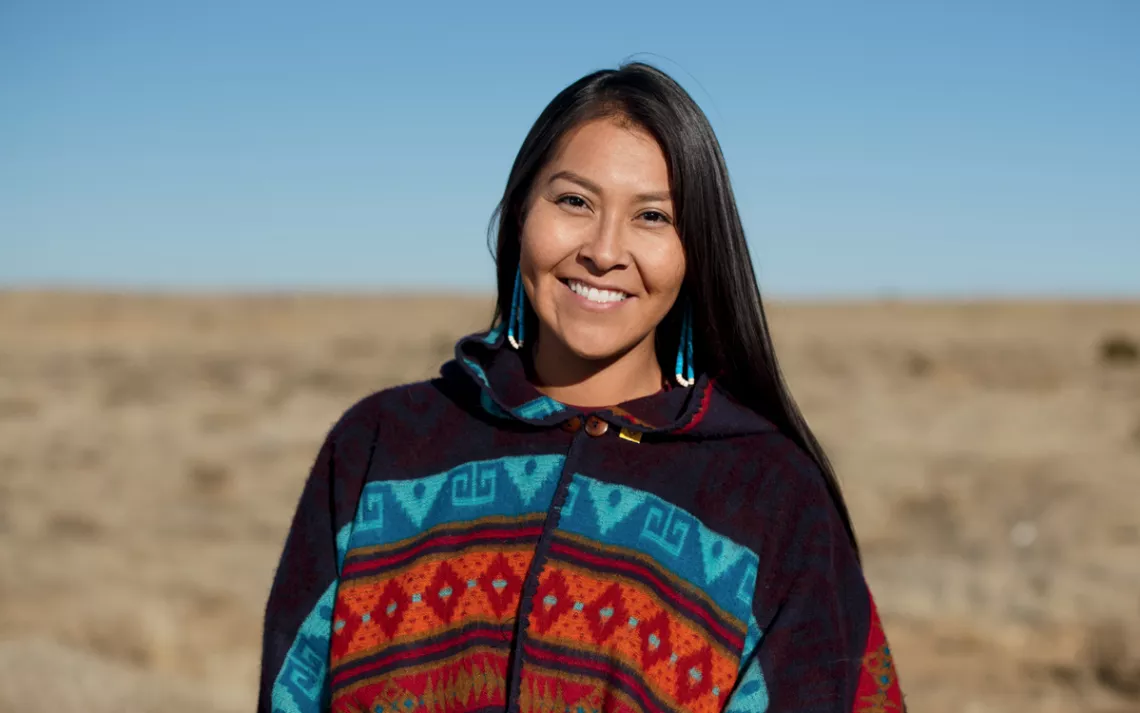
Activist Kendra Pinto has testified to Congress about fracking’s effects on her community.
BLM maps didn't even show Pinto's home until 2015, she says. Once, her father spotted two workers in a white truck driving around her house. He stopped them to ask what they were doing." All they said was, 'We're getting the coordinates,'" Pinto recalls. "And Dad said, 'Well, you're driving through people's front yards,' and they said, 'Oh, we weren't aware anyone lived here.'"
"That was like yesterday," Pinto says. "That got me angry."
The Ojo Encino Chapter formally protested the January 2017 lease sale, Tso says. But the BLM's Farmington office dismissed the complaint because it was sent by email rather than fax or post.
WITH SIERRA CLUB environmental justice organizer Robert Tohe at the wheel, Tso takes a small group on what he calls his "fracking reality tour" along dirt roads we share with tanker trucks, graders, and the ubiquitous white pickups of the drilling companies, tall flags waving from their beds like a cavalry charge so they can be seen at a distance over the sagebrush. The tour stops at a well site near Nageezi, where a massive explosion and fire in July 2016 burned for five days, requiring the evacuation of 55 people. A house where eight people live is about a hundred yards away. Wells are supposed to be 660 feet away from houses, Tso says, but the oil companies can request waivers—"that without exception are granted"—to come within 300 feet. The six wells at the site are already back in production.
A lot of money is coming out of the ground, but the people who live here are, for the most part, still desperately poor: Half the households have an annual income of $15,000 or less. Some households on single-acre "tribal trust" parcels don't even have running water and have to fill containers at "water stations" like the one we visit, run by the Christ for All Nations Pentecostal Church. Near the water pipe and spigots is a hogan—a traditional Navajo dwelling—labeled "hogan" like an exhibit in a museum. "Door's facing south," Tohe mutters; the other Navajos in the car nod. (The doors of hogans built by Navajos traditionally face east.)
Tso calls the people on tribal trust lots the have-nots. When a well goes in next to them, they don't get anything except noise, stink, and the risk of asthma and other diseases. Luckier families own "allotments," lands deeded in 1887 by the U.S. government to individual Navajo households in an effort to discourage communal ownership. Crucially, the allotments include subsurface rights, so the descendants of the original allottees—who now, generations hence, are not even necessarily tribal members—lease those rights to the oil companies. Many have: In 2015, $96 million was distributed to 20,835 allottees, though a federal audit showed that—in the past, at least—the payments were wildly uneven, with some Navajo allottees receiving 20 times less than others. Most of the wells here have been run by two companies, Encana and WPX. Ken McQueen, who used to be vice president of San Juan Basin operations for WPX, is now secretary of New Mexico's Energy, Minerals, and Natural Resources Department under Republican governor Susana Martinez.
At another stop on Tso's tour, a flare blazes brightly from atop a tall pipe, burning off excess methane. The Four Corners area is the largest source of fugitive methane emissions in the country; the amount that escapes is enough to heat every house in New Mexico. Tso shows us how to read the forest of flags that mark the maze of pipelines carrying the oil and gas first to Lybrook and then south, to Texas and beyond. From a rise we can see Mount Taylor (Tsoodzil, the Navajos' sacred mountain of the south) and Chaco's Fajada Butte, where, in midsummer, the noon sun will split a spiral pictograph with a dagger of light. When he can, Tso accompanies BLM site-review teams. He indicates the remains of an old sweat lodge; if he hadn't pointed it out to the BLM, he says, it would have been bulldozed for a well pad.
ON TOP OF THE possible destruction of sacred sites, fracking takes its toll on the health of people in the Eastern Agency. Marlene Thomas works at the chapter health clinic and does home health assessments. "There's a lot of asthma in the community now, people complaining about allergies," she says. "A lot of the older people, they don't even go out anymore. They just stay in their homes because of the smell."
Thomas herself moved from her home near Lybrook because of the smell and the noise of the gas wells, five of which sit directly across the highway from the town's elementary school. She now lives 12 miles to the south, but the gas development is already closing in. "It's not quiet like it used to be," she says. "I can't sleep."
A 2016 community health report on drilling in the basin found that local residents worried about flaring, about the dust, pollution, and accidents from the heavy truck traffic, and about livestock getting sick and dying after drinking from unfenced wastewater pits. In October 2016, Herbert Benally, a professor at Diné College in Shiprock, met with members of the Counselor Chapter to discuss the effects of fracking through the lens of Hózhóógó na'adá, traditional Navajo knowledge about health and well-being. The responses ranged far beyond complaints about asthma and poisoned sheep.
"Some hills, valleys, and springs around here have been held as sacred, where our ancestors from time immemorial made offerings and prayers," one participant said. "Recently, some of these valleys and hills have been desecrated as bulldozers have level[ed] them to the ground."
Said another, "We have a personal relationship with our land. Our umbilical cords are buried here, and our children, grandparents, friends, and neighbors are buried here, and it is sacred. This land is all we have, and we look, angrily, hurting and powerlessly watching while drilling and fracking desecrates our beloved homeland."
It can be difficult for local people to express such sentiments. Some allotment owners are making a lot of money from drilling leases, which predictably causes bad feelings on both sides. Also making a lot of money from fracking is the state of New Mexico. From each well, Tso explains, 20 percent of the royalties goes to the Feds and 20 percent to the state, providing roughly a third of New Mexico's budget. New Mexico state legislator Derrick Lente, who represents the greater Chaco area, says that the state "is pretty much handcuffed to the revenue stream from oil and gas."
The state's reliance on that funding, Pinto says, is used to silence Native American voices. "When someone like me comes out and says I don't want them drilling under my land, I'm the bad person," she says. "I'm the one that's saying, 'I don't want any money going to our school.' They always throw that in our face. So this state is running off our back here. They're still taking our land."
People see this land in different ways. To the BLM and the oil and gas companies, it's a neat checkerboard of federal land, state land, tribal land, and allotment land, ready for exploitation. Navajo people see it as their homeland, taken from them in 1864, when they were imprisoned at Bosque Redondo, and only partially recovered in 1868 with the establishment of the Navajo Nation. New Mexico's Pueblo people, although mostly now living outside the greater Chaco region, still feel very much connected. "Some people say that we abandoned Chaco," says Tim Menchego, cultural resource coordinator for the Pueblo of Santa Ana. "But we never left. We still depend on those sacred sites to practice our religion and culture."
At an institutional table in a hallway of Diné College, Arnold Clifford walks me through what some archaeologists call the "ritual landscape" of Chaco from a Navajo perspective. Clifford is a polymath—a geologist, an astronomer, and a botanist with a dozen new species to his name—in addition to being a repository of traditional cultural knowledge. He spins a dizzying tale, from the creation of the world to the movement of the mountain ranges into position, the alignments of the solstice sun and the constellations not with manmade structures but with the very mountains and landforms, the clash of deities at Chaco where the Big Gambler enslaved the Salt People and forced them to build the great houses but was then beaten at his own game and shot with a bow up to the moon.
"These stories I'm telling you, these are sacred stories," Clifford says. "I wouldn't normally ever give it away. But there's a need to get it out to people. We've always been here. It started from Chaco."
BACK IN THE OBAMA ERA, the BLM had started to revise its 2003 resource management plan, passed before the horizontal-drilling revolution. Rebecca Sobel, senior climate and energy campaigner with the Santa Fe–based WildEarth Guardians, says that the Obama-era BLM was at least responsive to the public; witness, for example, the 10 sessions it held to hear concerns in affected Eastern Agency communities.
Then came Trump, who is apparently deaf to native concerns. He chose a ceremony honoring the few remaining Navajo code talkers from World War II to once again call Massachusetts senator Elizabeth Warren "Pocahontas." He drastically shrank the Bears Ears National Monument in the face of near-unified tribal resistance. And pursuant to Trump's policy of "energy dominance," the Farmington BLM office readied a lease sale for March 2018 of nearly 4,500 acres in the greater Chaco area, including sites only 10 miles from the historic ruins.
The response was overwhelming—but not in the way Trump and the BLM envisioned. The proposed sale drew hundreds of calls for a moratorium on fracking and horizontal drilling in the greater Chaco region—"the most appeals ever received around an oil and gas lease sale in New Mexico," according to Sobel. Representative Lente got the state legislature to ask the BLM not to issue further leases in the Chaco area until a new resource management plan was in place. The National Congress of American Indians added its voice. And in a strong show of unity (their peoples have a somewhat prickly history), Navajo Nation president Russell Begaye and the All Pueblo Council of Governors joined the call, along with New Mexico's entire congressional delegation.
On March 1, a week before the planned lease sale, Interior Secretary Ryan Zinke pulled the plug. "We're going to defer those leases until we do some cultural consultation," Zinke told the Albuquerque Journal. "When there is an oil and gas decision and the risk is uncertain, it's in everyone's best interest to defer it and look at it more closely and examine it."
WHAT HAPPENED AT CHACO? What cataclysm drove a thriving civilization to self-deport along its majestic roads to nowhere, away from its painstakingly constructed city in line with the intricate mechanisms of the sun and the stars? Maybe it was drought. Maybe, as some legends suggest, it was a crisis of leadership. Or maybe, as some Pueblo people believe, it was just time to go.
Whatever that ancient cataclysm was, a new one is fouling the air, sickening the people, killing the sheep, expunging the shrines and the traces of those who came before. It would be easier for Encana, WPX, and the BLM if the people would pick up and go again, leaving the landscape to the bobbing pumpjacks, the flares lighting the night, and the white trucks flapping their flags.
But this time, the people of Chaco aren't going anywhere.
WHAT YOU CAN DO
Demand an end to new oil and gas leasing and drilling in the greater Chaco area. Call for real tribal consultation and health protections as well as cultural and environmental safeguards: sc.org/chaco.
Learn more about #FrackOffChaco, the coalition of Native American community leaders and groups and environmental organizations, including the Sierra Club’s Rio Grande Chapter: frackoffchaco.org.
MORE ONLINE
See for yourself the reality of fracking in the greater Chaco area via drone, courtesy of the Virginia River Healers: sc.org/chaco-drone.
 The Magazine of The Sierra Club
The Magazine of The Sierra Club



